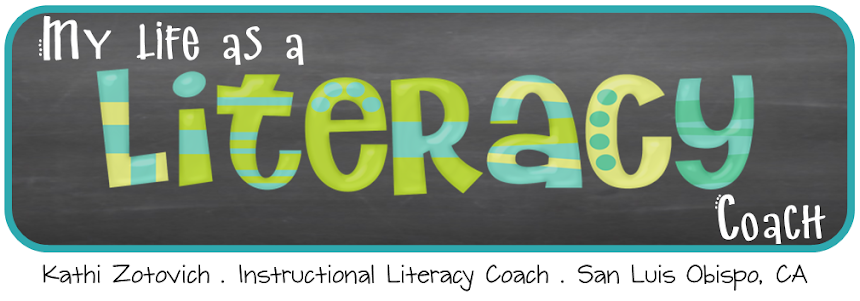Reflections & Understandings
about Authentic Writing Assessment in the Common Core Writing Workshop Block:
Part 1
This is the first post in a series about on-demand writing assessments, the teacher's role in
administering, collecting and reviewing student data, and how that data will
drive writing instruction.
So I'm sure you must be
thinking I fell off.... you know, but I assure you I've been very busy.
Actually, busier than I expected. During the last three weeks, I have
been facilitating training in my district using the new Units of Study writing
assessment tools from the Lucy Calkins Common Core Workshop Curriculum.These scoring days have been the first of series of four trainings that will be provided over the course of this year to all of our elementary school teachers. They consist of cycles of grade-level professional development training using the new units of study writing assessment tools.
by Lucy Calkins and Colleagues
Here’s how it works…
We
begin the data cycle by having teachers administer an on-demand writing
assessment prior to teaching in narrative, information or opinion/argument
writing text types. During the on-demand assessments all K-6 students are given
the same text-type specific writing prompt. (These were from They are asked to
demonstrate all they know about writing within that specific text-type of
writing in a forty-five minute sitting without any teacher support.
Our teaching on any given
day is designed to lift writers, not just for that day, or piece of writing, but
for every day and every future piece of writing they do. And we know that
students are going to be assessed on what they can do independently, so knowing
this, Lucy reminds us that we need to work with fervor to get students to
transfer and apply the learning they do with your support to new work they do
on their own. An on-demand allows a student to show-off what they can do
independently and that gives us, as teachers, a chance to measure the
stickiness of our teaching.
And why a pre and post?
I think we’re all used to an
end of unit assessment as a way of determining what a student has learned and
using it to determine whether or not they’re doing what they should be able to
do. This question is really about the
pre-assessment. Many teachers ask me, “Why would I assess students on something
they don’t know and that I haven’t taught them?” It doesn’t seem fair, or worth
our time.
Here’s why we do it:
1) It provides a baseline: We don’t know what our students know
when they walk in our door, or begin a new topic of study. The pre gives us
access to a starting place for each student, and it gives him or her an
opportunity to work at their level.
2) It allows teachers to self-reflect after a unit of instruction
and ask “How should I adjust my teaching and expectations going forward?”
3) It supports our conversations with parents at conference time –
a pre-post is specific evidence of learning and can be used to help parents
understand their child’s growth trajectory. This is where they were, this is
where they are, this is where they need to be, Here’s our plan for getting them
their.
4) It supports our conversations with students – it provides
visible evidence of their growth, which spurs them on to make more progress.
Educational research has
found that one of the most powerful things teachers can do in the classroom to
lift student achievement is to engage them in a meaningful and regular feedback
loop, using evidence (like the pre/post), goal-setting, conferring, and
self-assessment, like the student checklist, to lift learning.
These writing samples are
then collected and reviewed together with the company of their grade-level
colleagues beginning the first steps of a data cycle.
•
Step 1—Collect, sort
student work in high, medium and low piles and chart data (see sorting activity
below)
•
Step 2—List students’
strengths and areas of concern
•
Step 3— Prioritize areas
of concern
•
Urgent (+1)
•
May need
attention/remediation (+2)
•
Material will be covered
soon (+3)
•
Step 4- Identify
strengths
•
Step 5-Establish goals:
set, review, revise
•
Focus on one-high
leverage are of concern that will affect the most students
•
Step 6—Select
instructional strategies
•
Step 7—Differentiate
instruction
•
Return to step 1 and
identify teaching points for individual students to be used for small group
instruction and/or conferring
•
Step 8-Calendar when
progress will be reviewed
•
Next assessment date
Step 1- The sorting activity provides us with a quick way of seeing
trends and patterns across the classroom and is critical in determining what is
the high leverage area of concern we will target in instruction.
Next we can establish
trends and patterns across grade levels and determine areas of grade level
instructional focus.
Through studying performance assessments that differentiate
student work along a continuum and through reflecting on adult proficient
writing, teachers develop an understanding of the continuum of development. This
knowledge helps teachers explicitly teach writers in ways that help them
progress along a trajectory of skill development.
The Calkins Units of Study curriculum, is grounded in research on
evidenced-based teaching (see John Hattie's Visible Learning, Geoff
Petty's Evidence-Based Teaching , etc).
Teachers study what writers do, and consider goals that are
within reach yet rigorous. Teachers give feedback that helps writers understand
the progress they have made, and that which they still need to make, helping writers grasp onto important goals and work, deliberately practicing, so they
become more proficient.
Lucy reminds us- good instruction must be grounded in assessment.
Stayed tuned, in my next
post I’ll answer questions from a mylifeasaliteracycoach.blog follower and fellow
literacy coach- Crystal from Hampton, VA:
1)
How do teachers discuss
learning progressions across grade levels?
2)
What successes have you
experienced with using student checklist?
3)
What is your role as coach
in the process?










